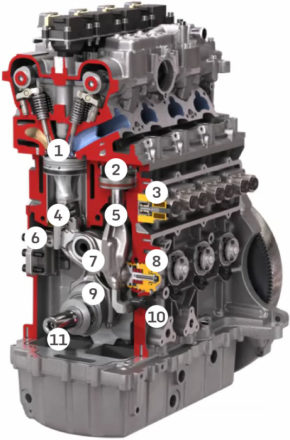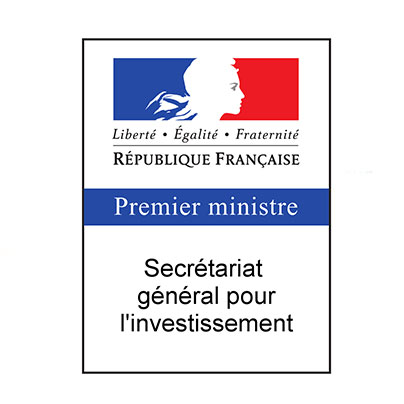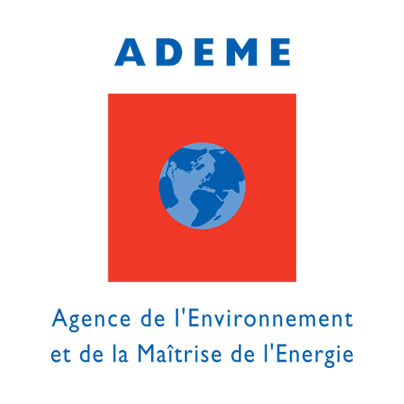WHY VCRi?
POURQUOI LE VCRi ?
Why VCRi?
Developing ever-cleaner spark ignition engines is a must in order to meet future automotive environmental regulations. Variable compression ratio is one of the key strategies to achieve such improvement, as it extracts the full benefit from high-efficiency thermodynamic cycles such as Miller or Atkinson extended expansion cycles without impeding driving dynamics.
How does VCRi work?
The volumetric compression ratio is the ratio of combustion chamber volumes at piston bottom and top dead centre positions.
VCRi technology adjusts the compression ratio by adjusting the position of the control cylinder piston (2) and rack (5); this rotates the gearwheel (7) about a gudgeon pin fitted to the connecting rod (9), thereby changing the datum position of the combustion rack (4) and the piston (1). The adjustment is powered by the inertia force (increasing compression ratio) or combustion gas pressure (decreasing compression ratio) applied to the piston. The control cylinder moves only when the compression ratio actuator (3) connects the control jack’s upper oil chamber with the lower. This control is provided by the engine management system, which sets the required compression ratio to an optimum value based on the engine’s running conditions and the actual compression ratio as measured continuously by the position transducer (10). The relative movements of the system are ensured by rolling without sliding and the piston is guided in the cylinder by means of the synchronizing roller (6), preventing any significant side loads, while the hydraulic side pusher (8) controls clearances in the system to ensure silent operation at all times. These two latter features provide a significant reduction in friction.
VCRi, a unique combination of characteristics
VCRi’s capabilities set it apart from competing variable compression ratio systems in that it provides a unique combination of features allowing the best possible use of extended expansion cycles such as the Miller cycle, thus delivering the best possible efficiency:
Compression ratio actuation based on internal gas and inertia forces
> Low energy consumption
Continuous and cylinder-selective variation of compression ratio
> Allow any advanced combustion mode
Wide compression ratio range (10 points)
> Operations without enrichment a high power density (up to 150 kW/l)
High maximum compression ratio (18:1)
> Maximises gains on extended expansion thermodynamic cycles
Closed loop control of compression ratio based on direct measurement on each cylinder
> Compliance to the most stringent on-board-diagnostics regulation
Compression ratio high accuracy (0.1 point of compression ratio at 15:1)
> Control of high compression ratios (greater than 15: 1)
Very fast compression ratio variation (1 cycle for a 2-point variation)
> Knocking mitigation based on compression ratio adaptation, allows optimum ignition advance setup
VCRi development programmes
The VCRi has been developed through a series of engineering programmes to which many technical partners have contributed, most specifically the following companies:
- ABOARD ENGINEERING
- AVL LIST
- BOSCH
- CERTAM
- CONTINENTAL
- DANIELSON ENGINEERING
- DONGFENG
- ELECTRICFIL
- FARINIA – SETFORGE
- MAHLE
- MECACHROME
- PEMTEC
- PSA GROUP
These programmes have attracted funding from the following public French and European institutions:
- ADEME, French Environment and Energy Agency
- BPIFRANCE
- CGI, French General Commission for Investment
- DGE, French General Directorate for Businesses
- ERDF, European Regional Development Fund
- “Grand Lyon”, the Greater Lyon council
- The Auvergne-Rhône-Alpes Region
- The Normandy Region












